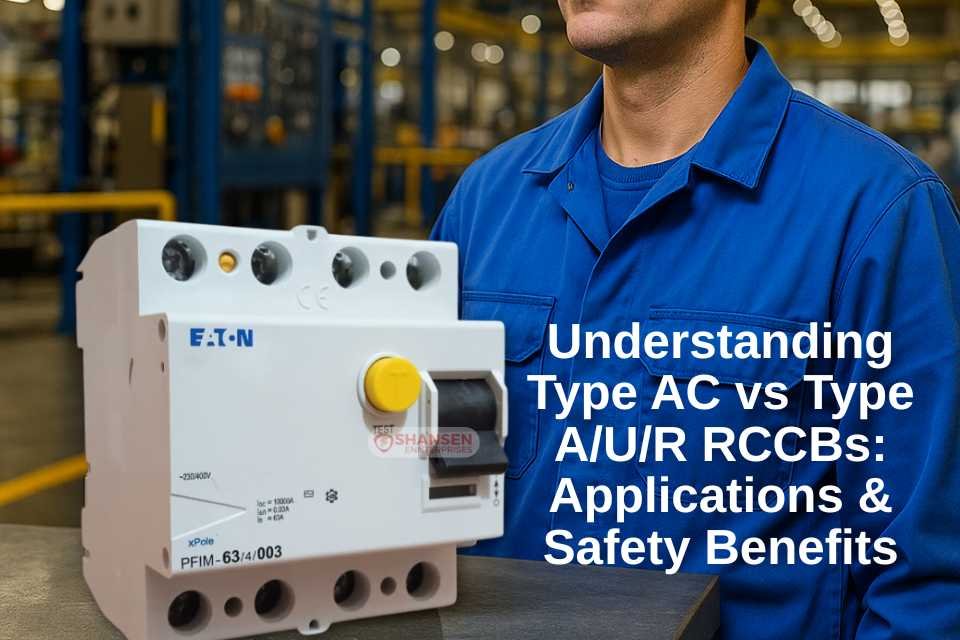Residual Current Circuit Breakers (RCCBs) are essential components in modern electrical installations. They protect both people and equipment from dangerous electric shocks and fire hazards caused by earth leakage currents. However, not all RCCBs are created equal. Today, we’ll break down the differences between Type AC, Type A, Type U, and Type R RCCBs—and guide you on when to use each.
What Is an RCCB?
An RCCB (Residual Current Circuit Breaker) is a safety device that disconnects power when it detects leakage current to earth above a specific threshold—commonly 30 mA. It’s critical in preventing electrocution and reducing the risk of electrical fires.
Understanding RCCB Types
Different types of RCCBs respond to different kinds of residual currents. Selecting the right type ensures your protection system is compatible with the electrical load and offers full protection.
- Type AC*: Detects pure sinusoidal AC leakage currents.*
- Type A*: Detects both AC and pulsed DC leakage currents.*
- Type U*: Enhanced Type A, adds protection for smoother DC leakage.*
- Type R*: Covers complex, high-frequency leakage currents like those from EV chargers or UPS systems.*
Type AC RCCBs: The Basics
Type AC RCCBs* are the most basic and widely used in traditional residential installations. They detect alternating sinusoidal residual current only. While affordable and reliable, they’re not suitable for devices that generate pulsed or smooth DC currents like variable speed drives, inverters, or computers.*
Type A RCCBs: Modern Standard
Type A RCCBs* go a step further by detecting pulsed DC in addition to AC leakage. They’re ideal for homes and offices where electronic devices such as washing machines, induction cookers, and LED lighting are common. Type A is now the recommended minimum in many new installations.*
Type U & Type R RCCBs: For Specialized Loads
Type U RCCBs* offer enhanced detection for smoother forms of DC residual current. They are often used in solar PV systems and industrial applications with high-frequency converters.Type R RCCBs are the most advanced—designed for highly sensitive environments. They detect residual currents with complex waveforms and frequencies. Common in medical setups, EV charging stations, and data centers.*
Application Guide: Choosing the Right Type
| RCCB Type | Detects | Typical Applications |
|---|---|---|
| Type AC | Sinusoidal AC | Standard lighting, resistive loads |
| Type A | AC + Pulsed DC | Residential appliances, office equipment |
| Type U | Type A + smooth DC | Solar inverters, variable speed drives |
| Type R | Complex waveforms, high freq. | EV chargers, hospitals, IT infrastructure |
Safety Benefits of Using the Correct RCCB
- ✅ Enhanced personal safety by cutting power during faults
- 🔥 Fire prevention from unnoticed earth faults
- 🛡️ Protection of sensitive electronics from partial tripping
- *⚡ *Compliance with modern electrical standards (IEC/EN 61008)
- 🏗️ Reduced downtime in commercial/industrial setups
Final Thoughts: Future-Proofing with Type A/U/R RCCBs
With evolving technology and increasingly complex loads, older Type AC RCCBs may not provide sufficient protection. Upgrading to Type A, U, or R ensures your installations are future-ready and compliant with safety codes. For peace of mind, always consult with certified professionals when selecting RCCBs—and choose authentic, branded products like Eaton Moeller xPole PFIM series, available via Shansen Enterprises – Authorized Channel Partner.
💬 Need a datasheet or expert advice? Message us on WhatsApp today for tailored RCCB recommendations and 100% verified product sourcing.




